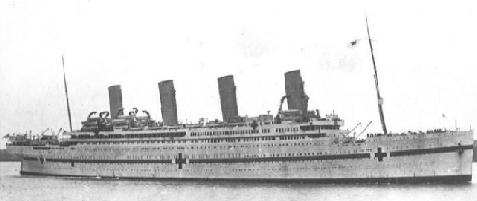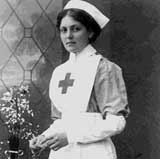Britannic (II)

Britannic (II), yard number 433, was the third Olympic Class ship, and the largest ship ever built for the White Star Line. Britannic is best known as being the sister ship of Olympic and Titanic, and also for her own sinking while serving as a hospital ship in 1916. Prior to her launching Britannic, had also been referred to as Gigantic, although it is uncertain whether or not White Star intended to use the name Gigantic.
In order to construct the Olympic Class liners Harland and Wolff constructed two massive slipways, 840ft by 270ft wide and up to 228ft high. Olympic was constructed on one side and Titanic on the other. Following the launch of both ships, on 30th November 1911, construction work begun on Britannic in the slipway that had been occupied by Olympic.
On 14th April 1912, Titanic collided with an iceberg and sank two hours and forty minutes later with the loss of around 1500 lives. As a result of the disaster it was decided to stop all work on Britannic until a safer design could be created following the Titanic inquiry – in an attempt to ensure that Britannic did not suffer the same fate as her sister, and also probably to increase public confidence in the ship.
When work continued on Britannic, a number of changes had been made to the design, most notably was the addition of lifeboats for all and large gantry davits to support some of them. Britannic also had her watertight double skin extended, a new bulkhead added and her bulkheads made higher.
Witnessed by some 50,000 people, Britannic was launched on Thursday 26th February 1914 at Harland and Wolff, Belfast. It was intended that Britannic would enter service as a passenger liner on the Southampton to New York service; however, World War One would intervene.
On 4th August 1914 Britain declared a state of war. As a result, work on Britannic was slowed down – as priority had to be given to ships involved with war services. On 13th November 1915, Britannic was requisitioned as a hospital ship.
As a hospital ship, Britannic’s duty was to transport wounded soldiers back home. To turn her into a hospital ship, Britannic’s interior was converted into wards, operating theatres…and accommodation for medical equipment and medical staff. So that Britannic could be easily identified as a hospital ship, Britannic was painted white with three large red crosses on each side, a green band going across the ship, and two further crosses on each side which were illuminated at night, this made sure that according to conventions, Britannic could not be legally targeted – providing that she was not used for military purposes other than transporting any wounded persons.
Upon completion Britannic sailed to Liverpool, where she arrived on 12th December 1915, under the command of Captain J Ranson. In Liverpool on 14th December, Britannic was officially commissioned as His Majesties Hospital Ship (HMHS) Britannic and given the identification number G618. Also on that same day Captain Charles A Bartlett took command of her.
On 23rd December 1915 Britannic’s maiden voyage began; she departed Liverpool bound for Naples, where she arrived on 28th December to take on coal and water, following Naples she headed for Mudros, on the Greek island of Lemnos, where she arrived on new year’s eve and took patients onboard. When Britannic left Mudros she sailed straight for Southampton, where she arrived on 9th January 1916. Unlike her younger sister, Titanic, Britannic’s maiden voyage – which had seen her crew celebrate Christmas on board – had been a success.
Britannic completed two more voyages, the first from Southampton (departing on 20th January 1916) to Naples, where the patients were transferred from smaller ships and the second from Southampton (departing on 20th March 1916) to Augusta, where patients were also transferred from other ships.
Due to the failure of the Gallipoli campaign, which had been supplying Britannic with casualties, Britannic was no longer needed, and was laid up at Cowes, Isle of White, UK. On 6th June 1916 Britannic was discharged from her war services, and returned to Belfast, so that she could be made ready for her true intended purpose, as a passenger liner.
Shortly after, due to new campaigns in the Balkans, Britannic was again needed, and was recalled back to war time hospital ship services on 28th August 1916. She departed Cowes on 24th September 1916 bound for Mudros, where she collected her patients from other hospital ships, and arrived home at Southampton on 11th October 1916.
Britannic made one more successful voyage, departing Southampton on 20th October 1916, for Mudros. On this voyage Britannic had been given permission to transport over 480 extra medical personal and tons of medical supplies that were destined for Egypt, Malta Salonika, India and Mesopotamia. Britannic arrived at her Southampton home on 6th November 1916.
Under the command of Captain Bartlett, Britannic’s sixth and final voyage started from Southampton on Sunday 12th November 1916. From Southampton she sailed to Naples, where she arrived on Friday 17th November for the loading of coal and water; Britannic was supposed to leave Naples the next day, but a storm had prevented her leaving until Sunday afternoon.
On the morning of Tuesday 21st November 1916, at 8.12am, Britannic was sailing in calm waters through the Kea Channel, when suddenly she was rocked by a massive explosion originating from her starboard side. The damage to the ship was serious, with watertight compartments flooding and bulkheads damaged. The situation was made even worse by the fact that many of the ships portholes had been left open – perhaps sealing Britannic’s fate.
It was not long before a distress signal was sent and the order given to prepare the lifeboats. In an attempt to save the ship Captain Bartlett attempted to beach the ship on shores of Kea. Without orders, two lifeboats had been lowered; in one of them was Violet Jessop, who had survived the Titanic disaster; once in the water these boats were sucked towards Britannic propellers, which where almost out of the water – resulting in devastation as boats and people were drawn towards them. Violet jumped out of the boat and despite hitting her head twice on something solid while struggling under water was able to get to the surface and survive the disaster.

Violet Jessop.
Soon after, Captain Bartlett ordered the engines to be stopped and at 8.35am he gave the order to abandon ship. At 9am the Captain give the last abandon ship order by sounding the ships whistle, and he then walked off the flooding bridge into the sea, where he swam to a lifeboat.
At 9.07am, 55 minutes after the explosion, Britannic slipped beneath the waves. The cause of the explosion is now widely believed to have been a mine. Of the 1066 people onboard, 30 lost their lives.
The wreck of Britannic was found by Jacques Cousteau in 1975 – in a relatively intact state, lying on her starboard side. Britannic is now the largest passenger liner fully submerged on the ocean floor; the only other passenger ship bigger than her lying on the sea bed being the Costa Concordia, which sank in 2012, but will eventually be raised.